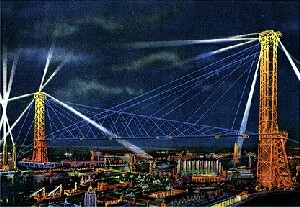|
1 |
 Copyright: |
|
1 |
 Copyright: |
The decision to place the exposition under a uniform theme not only had an impact on the choice and presentation of exhibits but also resulted in decisive changes for future World's Fairs. Now it was no longer a matter of product comparison or competition between nations which, with a few exceptions (Italy, Sweden, Czechoslovakia), dispensed with national pavilions this time. Instead they contributed to general, centrally coordinated exhibitions. Since the import of commercially exploitable exhibits were subject to high customs duties, the countries advertised with mock-ups of architectural sights or presented tourist attractions in the Hall of Nations at the Travel and Transport Building. The American states were given space at the Hall of States in the Federal and States Building. Only Illinois, as the host state, was allowed to set up its own guest house.
Multinationals had acquired more and more influence on the organization and character of World's Fairs in the USA, but the presentation of individual products had become less significant owing to industrial mass production. Large companies therefore focused on image enhancement at their pavilions by presenting their facilities in elaborate settings and in visions of the future. Some of them demonstrated production methods, such as the packaging of toothpaste tubes or the refining of oil in special factories that were set up for the fair. Consequently this exposition did entirely without a jury and awards – aspects which had characterized World's Fairs up to the beginning of the century.
The plan to present general human progress through the achievements of science, technology and industry over the past 100 years also caused the organizers of the fair to act as exhibitors themselves. The Science Advisory Committee prepared an encyclopaedic, popular science show which was dedicated to the impact of science on day-to-day life. Its goal was to illustrate the life cycle of products from their origin to their use in daily life. Across the board, vivid yet factual forms of presentation were given preference to decorative productions.
For the first time, innovative living and life concepts were presented in complex installations. In the "Home of the Future" section some single-family houses were shown that were made of steel, glass, concrete and prefabricated parts and which promised to make life better and cheaper for small families.
Despite these innovative approaches the fair failed to address the social and political impact of industrial and technical progress. The Wall Street Crash, which triggered the Great Depression in America and Europe, high levels of unemployment and the rise in social misery were disregarded at a time in which new concepts for the future of mankind were urgently needed. Furthermore, there were no exhibitions or pavilions for minorities or women.
| Year: 1933 | City: Chicago | Country: USA |
| Duration: 27th May - 12th November 1933 und 25th M | ||